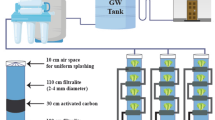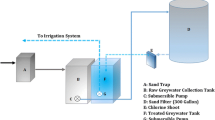Abstract
As global water resources decline, reuse of domestic greywater for the irrigation of home gardens is quickly becoming widespread in many parts of the world. However, the sanitary implications of reusing greywater to water edible crops remain uncertain. This study examined the benefits and risks associated with domestic greywater reuse for the purposes of vegetable garden irrigation. Untreated (settled only) and treated (settling and slow sand filtration) greywater collected from a family home was analyzed for basic water quality parameters over a period of 8 weeks. During that time, both greywaters were used to irrigate individually potted plots of lettuce, carrots, and peppers in a greenhouse. Tap water was used as control. Upon maturity, plants were harvested and the edible portions tested for fecal coliforms and fecal streptococci, common indicators for the presence of pathogenic microorganisms. Heavy metals were not detected in the greywater, but both fecal coliforms and fecal streptococci were present in high levels, averaging 4 × 105/100 mL and 2,000/100 mL of greywater, respectively. Despite these high counts, no significant difference in contamination levels was observed between crops irrigated with tap water, untreated greywater, and treated greywater. Fecal coliform levels were highest in carrots and fecal streptococcus levels were highest on lettuce leaves. However, contamination levels for all crops were low and do not represent a significant health risk. Plant growth and productivity were unaffected by water quality, owing to the low N, P, and K levels of the greywater. These results reinforce the potential of domestic greywater as an alternative irrigation source.




Similar content being viewed by others
References
American Public Health Association, American Water Works Association, Water Environment Federation (1998). Standard methods for the examination of water and wastewater (20th ed.). Washington, DC: APHA.
Armon, R., Dosoretz, C. G., Azov, Y., & Shelef, G. (1994). Residual contamination of crops irrigated with effluent of different qualities: a field study. Water Science and Technology, 30(9), 239–248.
Berthouex, P. M., & Brown, L. C. (2002). Statistics for environmental engineers (2nd ed.). New York: Lewis.
Brandes, M. (1978). Characteristics of effluents from separate septic tanks treating grey water and black water from the same house. Journal—Water Pollution Control Federation, 50(11), 2547–2559.
Casanova, L. M., Gerba, C. P., & Karpiscak, M. (2001). Chemical and microbial characterization of household graywater. Journal of Environmental Science and Health. Part A, Toxic/Hazardous Substances & Environmental Engineering, 36(4), 395–401. doi:10.1081/ESE-100103471.
Christova-Boal, D., Eden, R. E., & McFarlane, S. (1996). An investigation into greywater reuse for urban residential properties. Desalination, 106, 391–397. doi:10.1016/0011-9164(96)00134-8.
Collins, C. H. (2004). Collins and Lyne’s microbiological methods (8th ed.). New York: Arnold.
Eriksson, E., Auffarth, K., Henze, M., & Ledin, A. (2002). Characteristics of grey wastewater. Urban Water, 4, 85–104. doi:10.1016/S1462-0758(01)00064-4.
Franz, C. M. A. P., Holzapfel, W. H., & Stiles, M. E. (1999). Enterococci at the crossroads of food safety? International Journal of Food Microbiology, 47, 1–24. doi:10.1016/S0168-1605(99)00007-0.
Friedler, E. (2004). Quality of individual domestic greywater streams and its implication for on-site treatment and reuse possibilities. Environmental Technology, 25, 997–1008.
Gerba, C. P., & Smith, J. E. (2005). Sources of pathogenic microorganisms and their fate during land application of wastes. Journal of Environmental Quality, 34, 42–48.
Hall, H. E., Brown, D. F., & Angelotti, R. (1963). The recovery of Enterococci from food using KF streptococcus media. Journal of Food Science, 28(5), 566–571. doi:10.1111/j.1365-2621.1963.tb00244.x.
Hurst, C. J. (2002). Estimating the risk of infectious disease associated with pathogens in water. In C. J. Hurst, R. L. Crawford, G. R. Knudson, M. J. McInerney, & L. D. Stetzenbach (Eds.), Manual of environmental microbiology (pp. 309–319, 2nd ed.). Washington, DC: ASM.
Ibiebele, ., et al. (1986). Environmental movement of indicator bacteria from soil amended with undigested sewage sludge. Environmental Pollution, 40, 53–62 Series A.
International Commission on Microbiological Specifications for Foods (1986). Micro-organisms in foods 2: Sampling for microbiological analysis: Principles and specific applications. Toronto: University of Toronto Press.
Jackson, S., Rodda, N., & Salukazana, L. (2006). Microbiological assessment of food crops irrigated with domestic greywater. Water S.A, 32(5), 700–704.
Jefferson, B., Palmer, A., Jeffrey, P., Stuetz, R., & Judd, S. (2004). Grey water characterisation and its impact on the selection and operation of technologies for urban reuse. Water Science and Technology, 50(2), 157–164.
Madungwe, E., & Sakuringwa, S. (2007). Greywater reuse: A strategy for water demand management in Harare? Physics and Chemistry of the Earth, 32(15–18), 1231–1236.
Mills, R. G., Bartlett, C. L., & Kessel, J. F. (1925). The penetration of fruits and vegetables by bacteria and other particulate matter, and the resistance of bacteria, protozoan cysts and helminth ova to common disinfection methods. American Journal of Epidemiology, 5(5), 559–579.
Ottosson, J. (2003). Hygiene aspects of greywater and greywater reuse. Royal Institute of technology (KTH)/Swedish Institute for Infectious Disease Control (SMI), Stockholm: Licentiate Thesis.
Roesner, L., Qian, Y., Criswell, M., Stromberger, M., & Klein, S.(1994). Long-term effects of landscape irrigation using household graywater—literature review and synthesis. Resource Document. Water Environment Research Foundation. http://www.cleaning101.com/files/SDA_WERF_Graywater_2006.pdf. Accessed 20 January 2007.
Rosas, I., Baez, A., & Coutino, M. (1984). Bacteriological quality of crops irrigated with wastewater in the Xochimilco Plots, Mexico City, Mexico. Applied and Environmental Microbiology, 47(5), 1074–1079.
Rose, J. B. (1991). Microbial quality and persistence of enteric pathogens in graywater from various household sources. Water Research, 25(1), 37–42. doi:10.1016/0043-1354(91)90096-9.
Sadovski, A. Y., Fattal, B., Goldberg, D., & Katzenelson, E. (1978). High levels of microbial contamination of vegetables irrigated with wastewater by the drip method. Applied and Environmental Microbiology, 36(6), 824–830.
Surendran, S., & Wheatley, A. D. (1998). Grey-water reclamation for non-potable re-use. Journal of the Chartered Institution of Water and Environmental Management, 12, 406–413.
Toze, S. (2006). Reuse of effluent water—benefits and risks. Agricultural Water Management, 80, 147–159. doi:10.1016/j.agwat.2005.07.010.
World Health Organization.(2006). Guidelines for the safe use of wastewater, excreta and greywater. Resource document. WHO. http://www.who.int/water_sanitation_health/ wastewater/gsuww/en/index.html. Accessed 5 March 2007.
Acknowledgement
This project was financially supported by the Natural Science and Engineering Research Council of Canada.
Author information
Authors and Affiliations
Corresponding author
Rights and permissions
About this article
Cite this article
Finley, S., Barrington, S. & Lyew, D. Reuse of Domestic Greywater for the Irrigation of Food Crops. Water Air Soil Pollut 199, 235–245 (2009). https://doi.org/10.1007/s11270-008-9874-x
Received:
Accepted:
Published:
Issue Date:
DOI: https://doi.org/10.1007/s11270-008-9874-x




